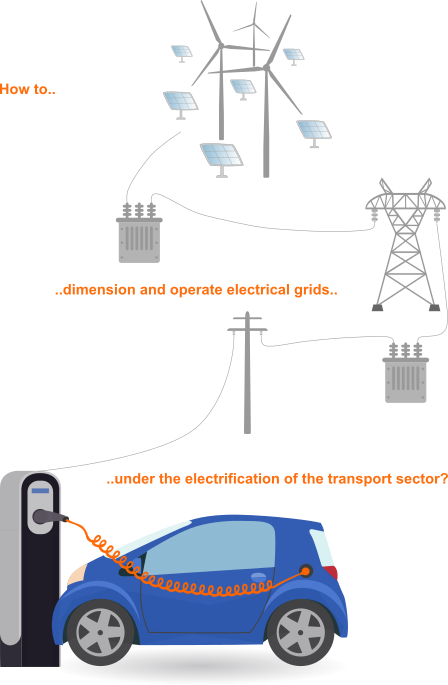EVAccel — Accelerating the Integration of Electric Vehicles in a Smart and Robust Electricity Infrastructure
The project aims to develop a new standard for dimensioning and operating electrical grids specifically for electric vehicle charging. For this, load flow analysis will be conducted at different voltage levels of the network in order to quantify the effect that charging strategies and behaviors have on the aggregated power ratios of the network. The calculated ratios will help distribution system operators in swiftly identifying network bottlenecks and take the necessary measures such as load management and new investments to ensure that electric vehicle penetration can continue to grow at an accelerated rate without threatening the robustness of the network.
Background:
In connection to climate targets, by 2030 it is ambitioned that the transport sector will reduce its emissions by 70% compared to 2010. For the past 10 years, the transport sector has swiftly reduced its carbon dependency by switching from fossil fuels to other alternatives at a faster rate than any other sector. However, as of today, it is still the sector with the highest proportion of fossil fuels, with a 76% share in its energy usage [1]. Even at the latest rate of fossil fuel reduction, there is a risk that the emission target is not reached in time. Consequently, in the coming 10 years it is crucial to accelerate the diversification of the transport sector towards other energy sources.Increasing the share of electricity use within transport is a most promising solution for achieving this needed transformation. Specifically, the rapid integration of plug-in electric vehicles (PEVs) within road transport. As of 2018, passenger cars responsible for 60.7% of the total transport emissions [2] and the electricity use in the sub-sector accounted for a minimal 2.2% share of the total energy use [3]. Both of these facts entail that there is an enticing potential to increase the share of PEVs and these would, in turn, cause a direct benefit in reducing the carbon footprint of the highest emitting transport subsector. Therefore, sector coupling between the transport and electricity sectors can definitively be an enabling force that accelerates the transition of the energy system into fossil freedom.
Motivation
When comparing different sectors within the Swedish energy system, the transport sector stands out as the one with the highest share of fossil fuel consumption, with 76% as of 2018 [1]. The electricity sector, on the other hand, is at the other end with only 1% of fossil fuel consumption. Increasing the interactions between these two sectors can thus accelerate the development of the transport sector towards fossil freedom and ensure the accomplishment of the 70% emission reduction target in 2030. Within this context, plug-in electric vehicles (PEVs) are a most promising sector-coupling solution. On the transport side, a high integration of PEVs would tackle the fossil dependency of the passenger car subsector, which is responsible for 60.7% of the total transport emissions [2]. On the electricity side, where the goal is to have a 100% renewable production by 2040, PEVs offer the possibility to balance the intermittencies of variable renewables and facilitate their integration. In addition, the smart use of PEV batteries unlocks a plethora of grid solutions and services (e.g. V2G, mobile storage) that can contribute to a more flexible and robust energy system and to a resource efficient society. However, before harvesting the mutual benefits of this match, there is a number of challenges to address on the electric system in order to accommodate a high share of PEVs.
Aim and Objective:

- Calculation of the aggregated power ratios due to PEV charging for the low voltage network districts and the intermediate network areas considering differences in charging behavior between residential and commercial customer types.
- Calculation of the aggregated power ratios subject to charging load management strategies for one of the areas, considering loss and costs optimization strategies.
- List of five key investment priority areas in the Stockholm region, in the short (3 years) and long (10 years) term, subject to critical limitations from PEV penetration.
- Develop a new standard for dimensioning and operating electrical grids specifically for PEV charging.
Funded by: Swedish Energy Agency.
Project partner: Ellevio.
Timeframe: 2021 - 2024
Researchers
References
[1] Statens energimyndighet, “Energiindikatorer”, ER 2020:18, Maj 2020.
[2] Naturvårdsverket ”Utsläpp av växthusgaser från inrikes transporter” [Available Online]: https://www.naturvardsverket.se/Sa-mar-miljon/Statistik-A-O/Vaxthusgaser-utslapp-fran-inrikes-transporter/
[3] Statens energimyndighet, ”Energiläget 2020”, ET 2020:1, 2020

